SaveGREEN - Hungarian-Slovakian cross border Transnational Experience Exchange workshop
27-06-2022
SaveGREEN carried out its latest Transnational Experience exchange workshop in Budapest, Hungary, and Lučenec, Slovakia, allowing for stakeholders from the agriculture, forestry, water and game management, and spatial planning sectors to engage in necessary exchanges on the challenges and threats of linear transport.
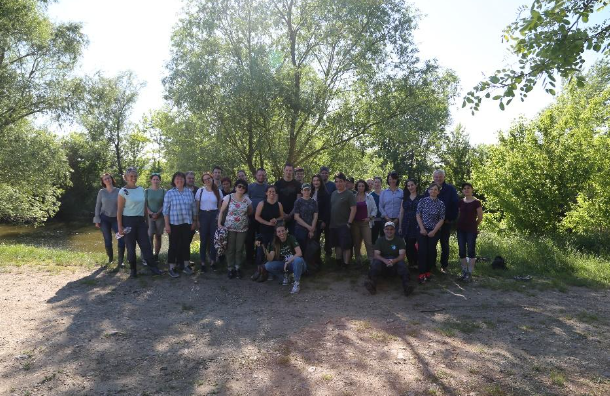
Group photo ©Aleksandra Khirv, CEEweb
The transnational meeting was organized in the Novohrad-Nógrád SK-HU cross-border area, located between South Slovakia and North Hungary, to facilitate the exchange of concrete solutions exchange relevant to the development of the local cross-sectoral operational plans (CSOPs). Moreover, it was also aimed at discussing the common challenges and ideas across Protected Areas (PAs), representatives of the local cross-sectoral working groups from all project countries, and key stakeholders. Furthermore, it served to hold the 4th Hungarian Local Cross-Sectoral Stakeholder Working Group (WG) meeting, which specific objective was to initiate a dialogue among the local representatives on one or more specific sectors (e.g. agriculture, forestry, water/ game management, spatial planning).
The gathering, thus, allowed the SaveGREEN to touch upon the topics of safeguarding, maintaining, improving and restoring the functionality of eco corridors in the surroundings of linear transport infrastructure passages. In other words, experience exchange and supporting project partners in finding the best solutions for the development of their respective CSOPs, as well as ensure synergies for the capitalisation of results with other DTP projects and support the development of a capacity-building programme.
The workshop also allowed for ever-needed communications training, carried out by the Estonian Fund for Nature, on the topic of negotiation and conflict management with stakeholders.
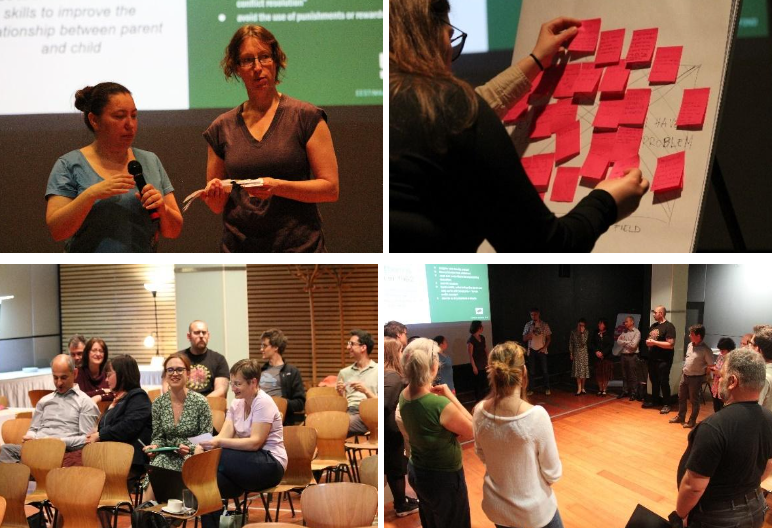
Communication training, Budapest ZOO ©Aleksandra Khirv, CEEweb
The workshop (in-depth)
With the participation of representatives from the Hungarian National Infrastructure Developing Private Company Limited, the Danube-Ipoly National Park Directorate, the Directorate of Water Management of Central Danube Basin, the Hungarian Biodiversity Research Society, the Hungarian Forestry Sector Knowledge Center, the Slovakian HBH Project, the IENE Secretariat, and many other relevant stakeholders and NGOs, Radu Mot, from SaveGREEN partner Zarand, presented the general goal of the CSOPs. Currently, they are in their 3rd stage, which means that the pressures, threats, specific objectives and the main stakeholders have been identified and now it’s time to define along with the stakeholders the specifics and create catalogues based on problems, measures and actions.
Later on, Dr László Kollányi presented the topic of ecological connectivity and green infrastructure in the Hungarian spatial planning system. He introduced the different planning systems and the Hungarian National Ecological Network in relation to the protected areas. Dr Kollányi highlighted the main problems of the National Ecological Network, as well as the challenges of the Green Infrastructure Plan and the national CAP of Hungary. Overall, CSOPs would be a great possibility in cross-sectoral issues in the new CAP support system. The biggest question, though, is who should prepare, finance and adopt the CSOP?
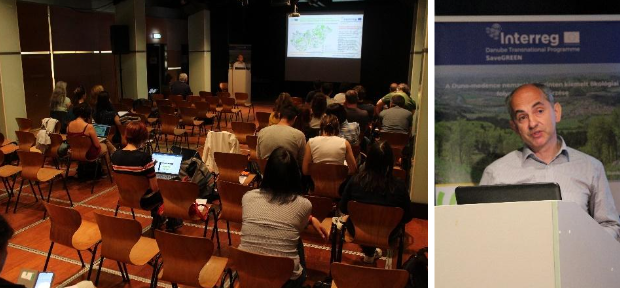
Presentation by Dr. László Kollányi, Budapest ZOO ©Aleksandra Khirv, CEEweb
Dr Krisztina Filepné Kovács presented the Nógrád-Novohrad pilot area of the project, with a focus on the landscape protection and the development of the cross-sectoral operational programme. The presentation introduced the pilot area via landscape analysis, comparing the trends of the land uses between 1842 and 2021. The results showed the issues of the planning processes of the M2 highway, namely the lack of hydrobiological research during the EIA processes, and the deficiencies of data collection resulting in poorly planned and parameterized ecological corridors, passes and combined crossways.
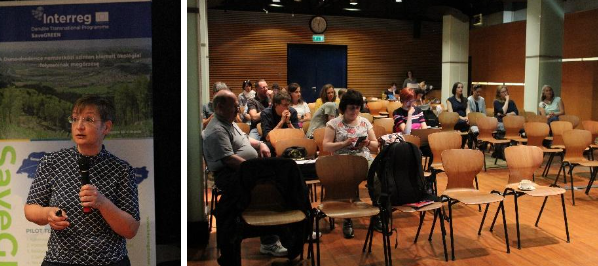
Presentation by Dr. Krisztina Filepné Kovács, Budapest ZOO ©Aleksandra Khirv, CEEweb
Dr András Weiperth introduced the topic of blue-green infrastructure and the ecological corridors in the area including the planned section of the M2 highway. The presentation included the main conflicts between humans and wildlife in the Hungarian pilot area, the dual role of bridges over watercourses, and the drainage areas around. Dr Weirperth introduced the research and sampling methods which are used to collect information for and beyond the SaveGREEN project.
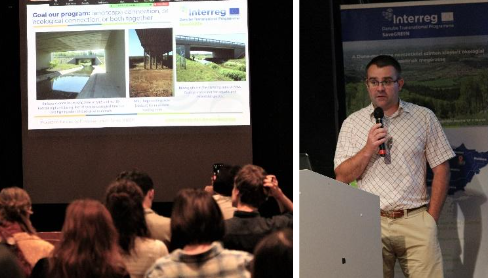
Presentation by Dr. András Weiperth, Budapest ZOO ©Aleksandra Khirv, CEEweb
Later, Romana Uhrinová, from WWF Slovakia, introduced the Slovakian CSOP. The presentation first introduced the basics of the pilot area, as well as the problems and threats identified by the Slovak experts (such as linear infrastructures, waste management, forestry, agriculture, and hunting, among others). Ms Uhrinová presented a typical issue from Slovakia through a case study from Stožok. Romana highlighted that WWF Slovakia is interested in finding the best solution for humans and wildlife as well (such as fencing and/or crop insurance for farmers in the critical zone); therefore, they expect the cooperation of the stakeholders.
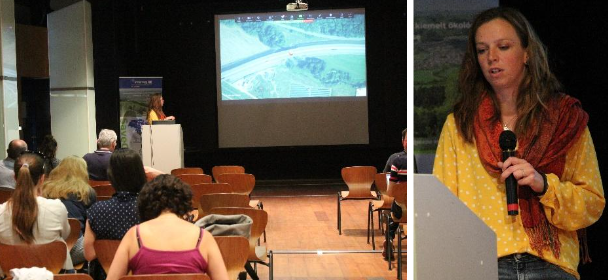
Presentation by Romana Uhrinová (WWF SK), Budapest ZOO ©Aleksandra Khirv, CEEweb
Fish, interrupted
The Hungarian-Slovakian cross-border pilot area, Nógrád-Novohrad, is one of the last remnants of the impermanent area of the Pannonian and the Carpathian Biogeographical regions. The unique specificity of the area is that, as it is a cross-border area, in some parts the Ipoly river flows along serving as a crucial blue infrastructure element and providing a rich habitat to many birds, amphibians, and aquatic species. Protecting this area is highly important as the planned infrastructure investments of extending the M2 road can threaten it. Therefore, there is a great opportunity to demonstrate the negative effects of infrastructure planning and bring attention to the importance of cross-sectoral cooperation in the planning and execution of such investment, as well as showcase possible solutions and SaveGREEN's findings.
As part of the World Fish Migration day, celebrated on 19 May, attendees visited the Hungarian side of the Nógrád-Novohrad pilot area, namely the fish ladder in Ipolytölgyes and the amphibian baffle system in Parassapuszta. The Ipoly river was divided into sections by 17 dams; even though it has many fish ladders, it still decreases the chance of successful reproduction of the aquatic species. The field visit also allowed for the stakeholders to better understand the real-life struggles of the “Barbus species” to reach their fish spawning sites by observing the problematic areas and “saving the fish” by catching them and bringing them to the fish spawning site by their own hands, thus feeling what is at stake.
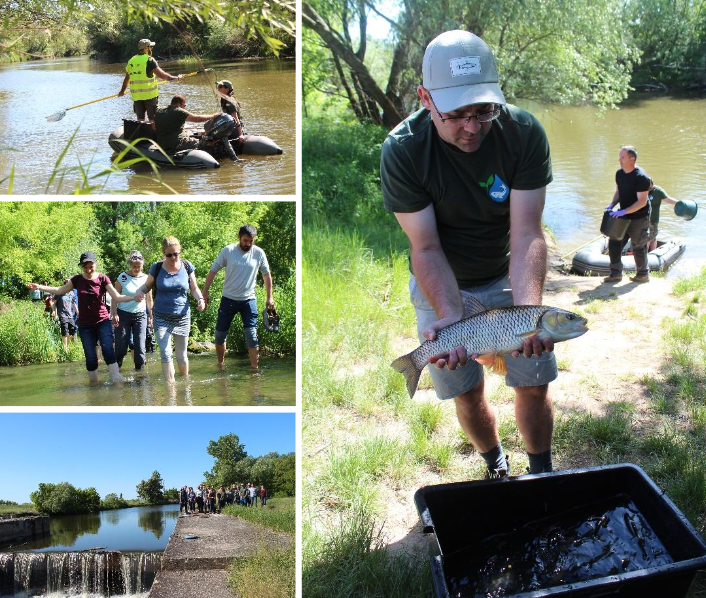
Mother fish saving and visiting the fish ladder in Ipolytölgyes ©Aleksandra Khirv, CEEweb
The second stop of the afternoon field visit was the amphibian baffle system, between Hont and Parassapuszta, where Dr Weiperth presented the temporal characteristics of the spring amphibian migration and the use of the tunnel-barrier system along with the main road No. 2. The tunnel was constructed in 2006 with the aim to avoid amphibians’ road kills on the side of this motorway, as well as to protect their migration during spring and autumn. Dr Weiperth highlighted that in the first three years of the tunnel’s maintenance already 9–15 % of the amphibians used the tunnels; however, over 10 000 amphibians died on the road section each year between 2009 and 2011.
Currently, nature conservationists organise annual toad rescue events during spring and autumn when volunteers are carrying out the frog from one side of the road to the other. The motorway is crossing the migration path of the frogs between the forest and the wetland; frogs are leaving the forest in springtime to reach the wetland and spend their summer there, and return to the forest around autumn to stay there during wintertime. Unfortunately, seven frog and toad species were recorded dead along the road, and almost 90 % were common toads Bufo bufo.

The field visit with the project partners, stakeholders, and Associated Strategic Partners. ©Aleksandra Khirv, CEEweb
Stay tuned for the Slovakian part of the summary soon!
Be a part of the SaveGREEN mission!
Follow our social media channels on Facebook and Twitter #SaveGREEN to stay updated and gain exciting green infrastructure insights!
Stay safe, stay curious, SaveGREEN!
See you at the IENE conference and the Capacity Building event series!
Author:
Eszter Sebestyén, CEEweb
Contributed by:
Viktória Selmeczy, Dr. Gabriella Nagy, Thor Morante, CEEweb
